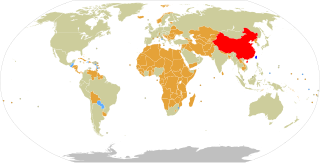
The Republic of China (ROC), often known informally as Taiwan, currently has formal diplomatic relations with 12 of the 193 United Nations member states and with the Holy See, which governs Vatican City, as of 7 November 2023. In addition to these relations, the ROC also maintains unofficial relations with 59 UN member states, one self-declared state (Somaliland), three territories, and the European Union via its representative offices and consulates under the One China principle. The Government of the Republic of China has the 31st largest diplomatic network in the world with 110 offices.
The term One China may refer, in alphabetical order, to one of the following:
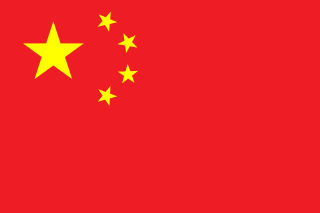
The Joint Communique of the Government of Japan and the Government of the People's Republic of China was signed on September 29, 1972, in Beijing. The communique established and normalized diplomatic relations between Japan and the People's Republic of China (PRC), resulted in the severing of official relations between Japan and the Republic of China (ROC) in Taiwan. The document produced nine articles in a joint statement, showing compromises on previously ambiguous principles enunciated by both sides. Of these, four points are particularly worthy of attention:
- the desire for a peace treaty between Japan and China;
- the statement that Japan "understands and respects [China's] stance" that Taiwan is part of the PRC;
- an Asia-Pacific anti-hegemony clause;
- Japan's reversal of relations with China and Taiwan.

The Taipei Economic and Cultural Representative Office (TECRO), also known as Taipei Economic and Cultural Office (TECO), Taipei Representative Office (TRO) or Taipei Mission, is an alternative diplomatic institution serving as a de facto embassy or a consulate of the Republic of China to exercise the foreign affairs and consular services in specific countries which have established formal diplomatic relations with the People's Republic of China. As the PRC denies the legitimacy of the ROC as a sovereign state and claims the ROC-controlled territories as an integral part of its China. An exclusive mandate namely One-China policy, mandates any country that wishes to establish a diplomatic relationship with the PRC must first sever any formal relationship with the ROC. According to The Fletcher Forum of World Affairs, "non-recognition of the Taiwanese government is a prerequisite for conducting formal diplomatic relations with the PRC—in effect forcing other governments to choose between Beijing and Taipei." As a result, these countries only allow the ROC to establish representative offices instead of a fully-fledged embassy or consulate for the purpose of conducting practical bilateral relations without granting full diplomatic recognition.

The Canadian Trade Office in Taipei is Canada's trade office in Taiwan, which functions as a de facto embassy in the absence of official diplomatic relations in which Canada recognized the People's Republic of China in October 1970 in accordance with the one-China policy.

South Korean–Taiwan relations

Oceania is, to the People's Republic of China and the Republic of China, a stage for continuous diplomatic competition. The PRC dictates that no state can have diplomatic relations with both the PRC and the ROC. As of 2019, ten states in Oceania have diplomatic relations with the PRC, and four have diplomatic relations with the ROC. These numbers fluctuate as Pacific Island nations re-evaluate their foreign policies, and occasionally shift diplomatic recognition between Beijing and Taipei. The issue of which "Chinese" government to recognize has become a central theme in the elections of numerous Pacific Island nations, and has led to several votes of no-confidence.
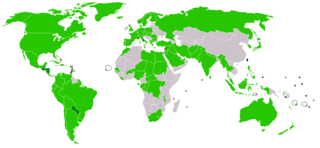
Numerous states have ceased their diplomatic recognition of the Republic of China during the last 70 years, since the founding of the People's Republic of China. Under the One China policy, the ROC is recognized by 12 UN member states and Holy See with 59 UN member states and Somaliland maintaining unofficial cultural and economic relations.

After the United States established diplomatic relations with the People's Republic of China (PRC) in 1979 and recognized Beijing as the only legal government of China, Taiwan–United States relations became unofficial and informal following terms of the Taiwan Relations Act (TRA), which allows the United States to have relations with the Taiwanese people and their government, whose name is not specified. U.S.–Taiwan relations were further informally grounded in the "Six Assurances" in response to the third communiqué on the establishment of US–PRC relations. The Taiwan Travel Act, passed by the U.S. Congress on March 16, 2018, allows high-level U.S. officials to visit Taiwan and vice versa. Both sides have since signed a consular agreement formalizing their existent consular relations on September 13, 2019. The US government removed self-imposed restrictions on executive branch contacts with Taiwan on January 9, 2021.

The bilateral relations between India and Taiwan have improved since the 1990s, despite both nations not maintaining official diplomatic relations. India recognises only the People's Republic of China and not the Republic of China's claims of being the legitimate government of Mainland China, Hong Kong, and Macau - a conflict that emerged after the Chinese Civil War (1945–49). However, India's economic and commercial links as well as people-to-people contacts with Taiwan have expanded in recent years.

Russia–Taiwan relations or Taiwan–Russia relations are the bilateral foreign relations between Taiwan and Russia. Due to the 2022 Russian invasion of Ukraine, relations became tense after Taiwan imposed sanctions against Russia. Russia placed Taiwan on a list of "unfriendly countries", along with South Korea, Japan, Singapore, the United States, European Union members, NATO members, Canada, Australia, New Zealand, Norway, Switzerland, Micronesia and Ukraine.
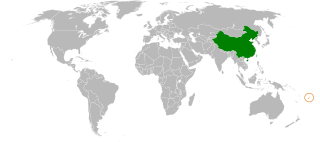
The Republic of the Fiji Islands was the first Pacific Island country to establish diplomatic relations with the People's Republic of China, in 1975. China established an embassy in Fiji in 1976, and Fiji opened its embassy in China in 2001.

The Republic of Kiribati and the People's Republic of China (PRC) established diplomatic relations on June 25, 1980, and resumed on September 27, 2019. Between 2003 and 2019, The government of Kiribati recognized the Republic of China, and, in accordance with the "One China" policy, the People's Republic of China did not have diplomatic relations to the country.
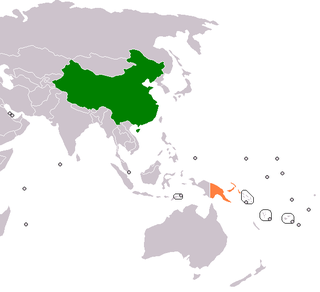
The Independent State of Papua New Guinea and China (PRC) established official diplomatic relations in 1976, soon after Papua New Guinea became independent. The two countries currently maintain diplomatic, economic and, to a lesser degree, military relations. Relations are cordial; China is a significant provider of both investments and development aid to Papua New Guinea.

Samoa and China (PRC) established official diplomatic relations in 1976. The two countries currently maintain cordial relations; China provides economic aid to Samoa.
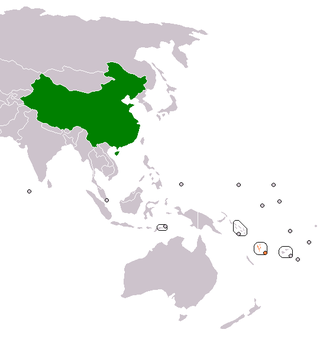
The Republic of Vanuatu and the People's Republic of China (PRC) established official diplomatic relations on March 26, 1982. China established an embassy in Vanuatu in 1989, while Vanuatu established an honorary consulate in China in 1999; it officially became an embassy in 2005. The current Ambassador of China in Vanuatu is Liu Quan. The current Ambassador of Vanuatu in China is former Minister of Finance Willie Jimmy.

Diplomatic relations between China and the Federated States of Micronesia were established on September 11, 1989. The Chinese government first established an embassy in the capital of Palikir in 1990, and dispatched its first ambassador in 1991. In April 2023, the Chinese government allegedly threatened to assassinate the Micronesian president, David Panuelo, and so, Micronesia severed official relations between the two countries. It said it decided to increase relations with Taiwan and it accused China of bribing officials and trying to control the United States’ influence in the region. Initially, the Micronesian ambassador to Tokyo, Japan also served as Micronesia's ambassador to China, before Micronesia established an embassy in Beijing in 2007. President John Haglelgam was the first senior government agent from Micronesia to visit China, doing so in 1990. The current Chinese ambassador to Micronesia is Zhang Weidong, while the Micronesian ambassador to Beijing is Akillino H. Susaia.

Canada and Taiwan have maintained unofficial bilateral relations since 1970. First contacts between Canada and Taiwan began in 1871 with the arrival of George Leslie Mackay.

The Australian Office in Taipei represents Australian interests in Taiwan in the absence of formal diplomatic relations, functioning as a de facto embassy. The Office is headed by a Representative.

The Republic of China (ROC) and Lithuania established diplomatic relations in 1921, three years after Lithuania's declaration of independence in 1918. The relations continued until the Soviet occupation of the Baltic states in 1940. The ROC did not recognise the Soviet annexation of Lithuania. The ROC lost the vast majority of its territory, namely mainland China, to the People's Republic of China (PRC) in 1949, and it has been limited to the island of Taiwan, formerly a Japanese colony and minor associated islands since the 1950s. Democratic Lithuania and modern-day ROC established unofficial diplomatic relations in 2021, thirty-one years after the restoration of Lithuania's independence in 1990.
























